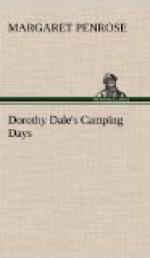“Is this your own horse?” asked Dorothy.
“No, but we have him for the summer. Mother insisted on us having a real old timer—safer, she thinks.”
“And he knows all the roads, that’s something,” added Dorothy. “If we should get lost he could find our way home for us.”
“Indeed, he could. I often give him the lines, and he goes along to the post office, and back again, without the slightest prompting. Here we are!”
Cologne drew up, not in front of a canvas tent, but beside a fine old barn.
“Is that the—tent—the camp?” asked Dorothy.
“Yes, but just wait until you see how we have it settled. There’s mother,” as Mrs. Markin appeared at the door and extended the most cordial welcome to Dorothy.
Swinging aside the great old-fashioned door, that opened in two parts, Cologne ushered Dorothy into the camp.
“Oh, how perfectly splendid!”
It was like a picture from an art magazine. The real rafters—no boxed-shaped beams set up like an uncovered porch roof—but rafters, that hung down low, fragrant with the scent of hickory, soft in tint, and brown with the polish and glow of years. Then the big field stone fire-place, with the “side walk” all around it, and the pieces of rag carpet!
“I have never seen anything so perfectly splendid!” chimed Dorothy, “how ever did you find such a camp?”
“The mater’s idea,” replied Cologne, enthused with Dorothy’s delight. “There used to be a big house on this farm, but it was burned down. Mother knew the place and we got it. Isn’t it a perfect mansion? Mater would not hear of us sleeping in the open—says tents fly away in the night. Let me show you the whole house.”
The first floor—for there was a loft—was laid out in a living room, with many luxuries even to a hired, old-fashioned, square piano; the chairs, Cologne explained, had been bought at a second-hand shop along the mountain road; and the man who kept the shop was so surprised to have a call for such odd chairs and tables that Mrs. Markin was able to pick up some splendid pieces for a mere trifle. Then the sleeping rooms, Mrs. Markin’s and her daughter’s, besides the guest room, were on the first floor, while Jack, the big boy of the family, had his “bunk” on the loft, and up there also was a “bunk” for any of Jack’s friends who might pay him a visit.
The first floor rooms were divided by cretonne partitions, or curtains, made secure top and bottom, and the coloring of these screens gave the place an ideal tone in color. The kitchen was outside under a lean-to tent.
And the dining room! A broad porch with an uncovered roof. A canvas flap was hung over the roof to be used, or thrown aside, just as the weather ordained. The table was a matter of two “horses” and three planks, and the seats were of the same brand, only in a lower grade. The cover was of oilcloth, and the dishes were some wooden and some white enamel.




